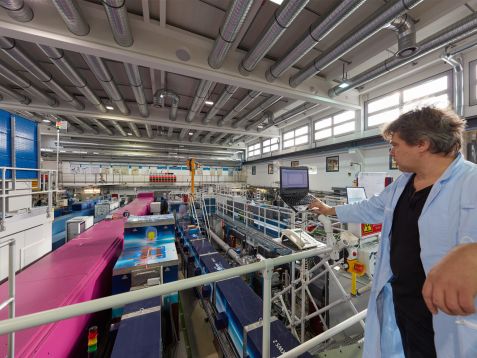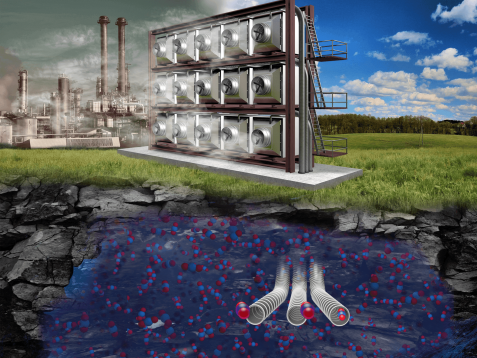MLZ is a cooperation between:
 > Technische Universität München
> Technische Universität München > Helmholtz-Zentrum Hereon
> Helmholtz-Zentrum Hereon
 > Forschungszentrum Jülich
> Forschungszentrum Jülich
MLZ is a member of:
 > LENS
> LENS > ERF-AISBL
> ERF-AISBL
MLZ on social media:

MLZ (eng)
Lichtenbergstr.1
85748 Garching
22.04.2024
Research on geological deposits: Investigating the porosity of sedimentary rock with neutrons
Whether sedimentary rocks store fossil hydrocarbons or act as impermeable layers to prevent the rise of oil, natural gas or stored carbon dioxide – all depends on their porosity. The size, shape, organization, and connectivity of the pore spaces are decisive. At the Heinz Maier-Leibnitz Research Neutron Source (FRM II) at the Technical University of Munich (TUM), the networks of micropores were characterized using small and very small angle neutron scattering.

Instrument scientist Dr. Vitaliy Pipich controls the small-angle scattering system KWS-3 of the research center at MLZ. © Bernhard Ludewig
Dense, dark, compact. At first glance, the sedimentary rock samples that Dr. Amirsaman Rezaeyan has on his lab desk are only slightly different. Pores are not visible to the naked eye. Nevertheless, it is precisely the pores that give the mudrocks their special properties: The pores, ranging from a few micrometers to sub-nanometers in size, are formed during sedimentation and compacted over time, determining the permeability. These pores are the decisive factor for the rock’s ability to reside oil and natural gas or form impermeable layers under which the fossil fuels collect.
“Depending on the distribution, size and structure of the pores, the fine-grained sedimentary rocks are also suitable for disposing of radioactive waste or sealing carbon dioxide storage,” explains Dr. Amirsaman Rezaeyan, a researcher at the University of Calgary in Canada. “The pore structure of mudrocks and its influence on the permeability for fluid flow have hardly been studied to date but are enormously important if you want to assess the potential of mudrocks as oil reservoirs or impermeable layers.”
But how do you measure pores that are not bigger than bacteria? There are actually various methods that can be used to quantify the pore volume, but most of them can only detect larger structures or limited pore sizes. “Only small and very small angle neutron scattering is suitable for fully quantifying pores between a few nanometers and micrometers,” emphasizes Rezaeyan, who, together with an international team at the Heinz Maier-Leibnitz Research Neutron Source (FRM II) at TUM, has analyzed the porosity of a dozen sedimentary rocks from Europe and America.
Measuring pores with nanometer precision
There are only a few measuring facilities for Small Angle Neutron Scattering (SANS) and Very Small Angle Neutron Scattering (VSANS) around the world. Two of them, KWS-1 and KWS-3, are operated by Forschungszentrum Jülich at the Heinz Maier-Leibnitz Zentrum (MLZ). The MLZ is the scientific cooperation between TUM, Forschungszentrum Jülich and Helmholtz-Zentrum Hereon, which makes the neutrons of the FRM II available to guest researchers in the form of scientific instruments. And so Rezaeyan from the Lyell Centre at Heriot-Watt University in Edinburgh, Scotland, where he was working at the time, traveled to Garching with his rock samples – all thinly polished and without gas or liquid inclusions – to detect micropores.
The samples were irradiated with neutrons from the reactor in the small-angle scattering instruments at the FRM II. As neutrons only interact with the nuclei of atoms, the diffraction pattern recorded by the detector can be used to deduce the arrangement of the atoms and thus – indirectly – that of the atom-free pores.
Back in Scotland, the researcher correlated the measurements with the microscopic properties of the rock samples. The result has now been published: the porosity of the fine-grained mudrocks is dependent on the proportion of clay minerals contained in the sediments: The more clay, the greater the probability of smaller pores, which have a diameter of less than 50 nanometers. Rocks with a high clay content are therefore potentially well suited for sealing a disposal or storage place underground as an impermeable layer.
“However, clay content is only one piece of the puzzle: there are a whole range of factors that need to be taken into account when selecting suitable mudrock layers for production of oil and gas or CO2 storage,” emphasizes Rezaeyan. “We therefore included other factors in the data analysis, such as rock compaction and organic matter. Doing this, we were able to establish correlations of high statistical significance.”
With the help of these correlations, it should be possible in future to estimate the physical properties of fine-grained sedimentary rocks based on the sedimentation conditions and to find out whether they are suitable as impermeable layers for nuclear waste repositories and CO2 storage sites.
Original publications:
Amirsaman Rezaeyan, Niko Kampman, Vitaliy Pipich, Lester C. Barnsley, Gernot Rother, Clayton Magill, Jingsheng Ma, Andreas Busch
Compaction and clay content control mudrock porosity
Energy, Volume 289, 129966 (2024)
10.1016/j.energy.2023.129966
Amirsaman Rezaeyan, Niko Kampman, Vitaliy Pipich, Lester C. Barnsley, Gernot Rother, Clayton Magill, Jingsheng Ma, and Andreas Busch
Evolution of Pore Structure in Organic-Lean and Organic-Rich Mudrocks
Energy Fuels 2023, 37, 21, 16446 – 16460
10.1021/acs.energyfuels.3c02180
Contact:
Dr. Amirsaman Rezaeyan
Department of Earth, Energy, and Environment, University of Calgary,
Calgary T2N 1N4, Alberta, Canada
Email: amirsaman.rezaeyan@hw.ac.uk, amirsaman.rezaeyan@gmail.com
phone: +1 403 220 3443
Further information:
The following institutions were involved in the study:
- Lyell Centre, Institute of GeoEnergy Engineering, Heriot-Watt University, Edinburgh, UK
- Nuclear Waste Services, Didcot, UK
- Forschungszentrum Jülich GmbH, Jülich Centre for Neutron Science JCNS at Heinz Maier-Leibnitz Zentrum MLZ, Garching
- Chemical Sciences Division, Oak Ridge National Laboratory, Oak Ridge, USA
- Lyell Centre, Institute of Life and Earth Sciences, Heriot-Watt University, Edinburgh, EH14 4AS, UK
- Institute of GeoEnergy Engineering, Heriot-Watt University, Edinburgh, EH14 4AS, UK
- Department of Earth, Energy, and Environment, University of Calgary, Calgary, T2N 1N4, AB, Canada
- Australian Synchrotron, ANSTO, Clayton, Australia
MLZ is a cooperation between:
 > Technische Universität München
> Technische Universität München > Helmholtz-Zentrum Hereon
> Helmholtz-Zentrum Hereon
 > Forschungszentrum Jülich
> Forschungszentrum Jülich
MLZ is a member of:
 > LENS
> LENS > ERF-AISBL
> ERF-AISBL
MLZ on social media:




